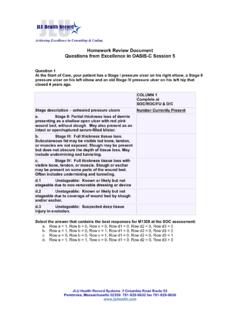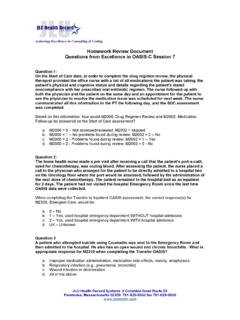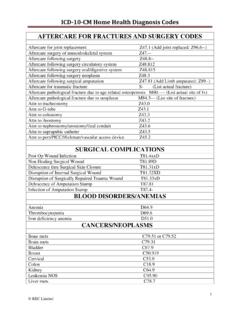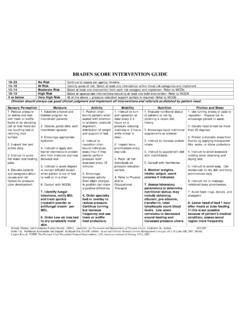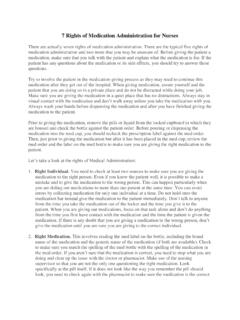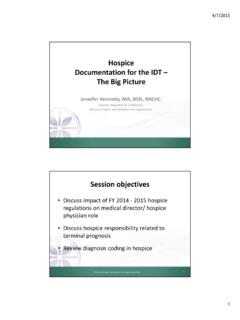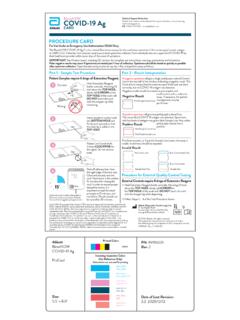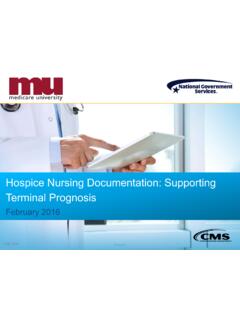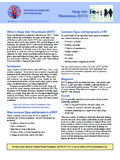Transcription of Infusion Therapy - Central Line Occlusion and TPA
1 HHVNA Infusion Therapy Central line : Occlusion AND TPA CONSIDERATIONS: 1. Occlusion of Central line catheters can be caused by: a. catheter tip lodged against venous/atrial wall. b. kinking of tubing under dressing c. precipitation of infusate within catheter . d. thrombus or fibrin clots formation 2. Patients with Central venous catheters should be assessed for signs of Central vessel Occlusion such as swelling of the extremity, shoulder, chest, neck or face. Signs of Central vessel Occlusion should be reported to the physician immediately. 3. When the catheter tip is lodged against the wall of the subclavian vein, superior vena cava or right atrium, the catheter will not function. Changing the patient's position, raising arms above head or performing the Valsalva maneuver may help dislodge the catheter tip.
2 4. Difficulty in drawing blood from an implanted Central vascular access device is common due to the structure of the reservoir and catheter . 5. Blood should only be drawn from PICC catheters that are French or larger. PICC lines may also be vulnerable to kinking under the dressing. 6. Studies have shown the presence of thrombus or fibrin around tips of most long-term catheters, regardless of catheter function, which can cause catheters to become sluggish and block lumen when attempting to aspirate blood. 7. Force must not be used to clear an IV catheter because of the risk of rupture and subsequent catheter embolism. Only syringes 10 mL or greater should be used. 8. Clotting of the catheter is generally caused by running an Infusion too slowly, turning off the pump accidentally for prolonged periods of time or inadequate or infrequent irrigation of the line .
3 9. If the Occlusion is caused by thrombus or fibrin formation, alteplase may be ordered to declot the line . Alteplase is a tissue plasminogen activator (t-PA), used as a clot buster for myocardial infarction and stroke. Marketed as Cathflo Activase, it can also be used to de-clot a Central line . Alteplase is an enzyme that converts plasminogen into plasmin, which then degrades the fibrin existing in blood clots. About 90% successful in dissolving clots, it will not restore patency of a catheter caused by medication precipitation. 10. Alteplase is reconstituted with sterile water just before use. Alteplase 2mg/2mL is administered into the catheter (most Central lines are less than 2 mL volume), and aspiration is attempted at 120 minutes or every 30 minutes up to 4 times.
4 If unsuccessful, the whole procedure can be repeated a second time. A. TROUBLE-SHOOTING Occlusion EQUIPMENT: Gloves Alcohol applicator (wipe/swab/disk/ampule) 10 mL syringes (5) Needles or needleless adaptor Normal saline Heparin solution Puncture-proof container Impervious trash bag PROCEDURE: 1. Adhere to Standard Precautions and explain procedure/purpose. 2. Clean connection of catheter injection port and tubing with alcohol using friction. Allow to air dry 3. Wrap new alcohol wipe around connection and hold in place until disconnecting injection port or line 4. Remove injection port or tubing and attach normal saline syringe to catheter hub. Open clamp, and attempt to irrigate catheter gently.
5 Do not forcefully attempt to flush 5. If resistance is met, repeat irrigation attempt after asking patient to: a. reposition self, from one side to another b. raise arms above head c. perform Valsalva manueuver 6. If irrigation attempts are unsuccessful, clamp catheter , remove normal saline syringe and attach empty 10 mL syringe and attempt to aspirate blood from catheter . a. If successful in aspirating blood, clamp catheter , attach normal saline syringe and vigorously flush to remove all the blood from the catheter . Attach intermittent injection port. 7. If unable to aspirate blood, check line for any kinks under dressing. (Will need to redress following Central line dressing procedure.)
6 8. If all efforts to flush line are unsuccessful, notify physician for further orders which may include alteplase administration. AFTER CARE: 1. Document in patient record: a. Measures taken to flush/aspirate line b. Communication with physician about Occlusion B. ALTEPLASE/TPA ADMINISTRATION EQUIPMENT: Cathflo Activase (alteplase, TPA) 10 mL syringes (2) 3-way stopcock HHVNA Infusion Therapy Central line : Occlusion AND TPA 10 mL saline flush Heparin flush per agency policy PROCEDURE: 1. Adhere to Standard Precautions and explain procedure to patient. 2. Ascertain catheter Occlusion , check for external mechanical obstructions. 3. Obtain physician order to attempt to restore venous device patency.
7 Order should state specifically: Alteplase/t-PA (CATHFLO ) 2 mg/2mL, instill and dwell into vascular access device (indicate type of device). If patency not restored, may repeat one time. 4. Wash hands, set up a clean work area and gather supplies. 5. Assess patient for signs/symptoms of superior vena cava (SVC) syndrome or venous thrombosis (swelling in neck, face, shoulder, or arm on the same side as the catheter .) If present, notify physician and DO NOT instill TPA. 6. Clamp catheter to prepare for TPA instillation. 7. Mix and dilute TPA as per manufacturer guidelines: a. Draw up mL sterile water, using 10 mL syringe, instill into alteplase (TPA) vial. b. Swirl DO NOT shake to dissolve c.
8 Withdraw 2 mL TPA solution in 10 mL syringe 8. Clean catheter hub with alcohol wipe. 9. Remove extension tubing and end cap DO NOT instill through an extension (if implanted Central venous device, remove end cap and leave Huber needle in place). 10. If line flushes, attach TPA syringe directly to line and instill. 11. If line will not flush, attach stopcock. 12. Attach the 10 mL syringe with 2 mL TPA onto the stopcock valve in line with the catheter (opposite the off position). 13. Attach the second 10 mL empty syringe onto the other stopcock valve. 14. Turn the stopcock lock to the TPA syringe. 15. Open the catheter clamp. 16. Using the empty syringe, gently pull back on the empty 10 mL syringe to create negative pressure in the catheter .
9 If possible pull back to 8 - 9 mL. This will remove any substance between the intraluminal clot and the catheter hub, clearing a path for the TPA administration. 17. Turn the stopcock lock to the negative pressure syringe. 18. The TPA solution should flow into the catheter . DO NOT force the TPA solution into the catheter . 19. If necessary, repeat steps 15-17 until the full 2 mL TPA has entered the catheter . 20. Close the stopcock lock to the patient. 21. Remove the negative syringe, replace with needleless end cap. 22. Label cap with tape, indicating that TPA has been instilled. 23. Clamp catheter . 24. Leave empty TPA syringe in place. 25. Allow 120-minute dwell time or per physicians order (may indicate attempt aspiration every 30 minutes).
10 26. Unclamp the catheter . 27. Turn stopcock lock to needleless cap 28. Attempt to aspirate the TPA and blood from the line . Continue to aspirate until 5 - 10 mL of blood is obtained in the syringe. 29. Turn the stopcock lock to aspirate syringe. 30. Clamp catheter line . 31. Remove stopcock piece and syringe. 32. Clean catheter hub with an alcohol wipe. 33. Prime extension tubing and needleless cap with normal saline, attach to catheter 34. Flush line with 10 mL normal saline. 35. Final flush catheter with heparin flush solution per catheter type and physician s order. 36. Clamp catheter . 37. If a patent catheter with a blood return is not obtained, repeat process as ordered: a. Second instillation may be up to 120 minutes, or even overnight (8 hours) if ordered by the physician b.

